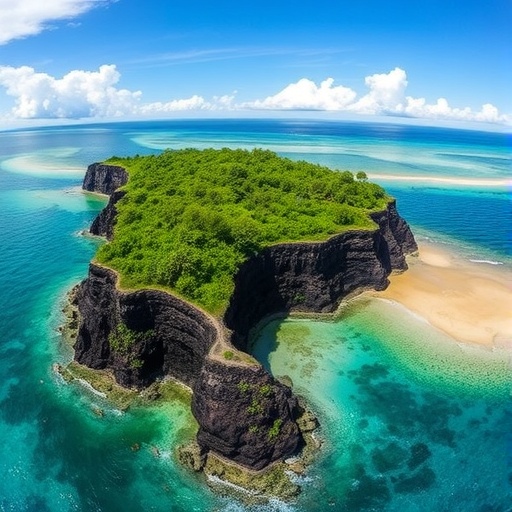In a groundbreaking study published in the journal Environmental Science and Pollution Research, researchers have explored the intricate relationship between the erosion of ultramafic massifs and their consequential effects on the geochemistry and sedimentary deposits within the tropical lagoons of New Caledonia. This region, known for its captivating biodiversity and pristine marine ecosystems, is now facing critical shifts driven by geological and anthropogenic processes. The investigation led by Chifflet, Gonzalez, and Delanghe aims to illuminate how these natural phenomena interplay, ultimately affecting aquatic life and coastal environments.
The ultramafic massifs in question are unique geological formations predominantly composed of magnesium-rich silicate minerals. Their geological characteristics profoundly influence the surrounding ecosystem’s chemistry. However, the erosion of these massifs raises concerns not only for the terrestrial landscapes but equally for the adjacent marine environments. Researchers observed that the rates of erosion have been accelerating due to climate variability and human activities, with severe implications for sediment input into lagoon ecosystems.
Sediment pathways are particularly crucial in understanding the ecological dynamics at play. The erosion of ultramafic terrain introduces significant quantities of metals and nutrients into the lagoons. This influx can lead to distinct shifts in the chemical composition of lagoon waters. Elevated levels of trace metals, in particular, could pose risks to marine biota, affecting everything from phytoplankton growth to larger marine species, which rely on these organisms as primary food sources. The researchers highlight the urgent need to monitor these changes closely, as they could trigger cascading effects throughout the food web.
In addition to immediate ecological impacts, sediment deposition shaped by erosion processes can alter physical conditions in lagoons. Variations in sediment texture and composition can affect light penetration, temperature stratification, and habitat availability for various species. For instance, finer sediments may settle more slowly, leading to altered habitats preferred by juvenile fish species, which are sensitive to seasonal temperature shifts. This change can have long-term implications for fish populations and the fisheries they support, further threatening local economies dependent on these resources.
The researchers conducted extensive fieldwork and sampling missions throughout tropical lagoons in New Caledonia, meticulously analyzing sediment cores and water samples to assess geochemical variations. Their results indicate a significant correlation between levels of erosion at the ultramafic massifs and the ensuing geochemical shifts in lagoon waters. This comprehensive approach emphasizes the necessity of integrating geological assessments with ecological studies to understand and manage coastal ecosystems effectively.
Monitoring the health of these ecosystems is paramount, especially considering that many tropical lagoons serve as nurseries for marine life and are critical to maintaining biodiversity. Enhanced erosion rates can lead to increased turbidity, which may smother sensitive coral reefs and seagrass beds, vital habitats for numerous marine species. The intricate balance of these ecosystems can be dramatically disrupted, emphasizing the intertwined fate of geological processes and biological networks.
Public awareness of these issues is another facet the researchers underscore. Engaging local communities and stakeholders in understanding the implications of ultramafic erosion is essential for stakeholder-driven conservation efforts. Educational initiatives aimed at demonstrating the connection between geological phenomena and marine health could foster greater stewardship of these vulnerable environments.
The research team further points out that addressing the challenges posed by ultramafic erosion is not solely an environmental issue but also a socio-economic one. The livelihoods of local communities, many of whom rely on fishing and tourism, are intricately linked to the health of marine ecosystems. Policy frameworks that recognize these connections are crucial in cultivating sustainable practices that mitigate erosion and promote resilience within these coastal communities.
In conclusion, the erosion of ultramafic massifs in New Caledonia represents a focal point for understanding the broader environmental challenges that many tropical regions face. This study underscores the importance of interdisciplinary approaches that bridge geology, ecology, and community engagement, providing a robust foundation for addressing the complex dynamics of coastal ecosystems. As researchers continue to unravel the mysteries of these interactions, the hope is for improved management strategies that safeguard both the environment and the human communities that depend on it.
In unveiling the intricacies of this relationship, Chifflet and colleagues have opened new avenues for research and debate, urging scientists and policymakers to prioritize the preservation of fragile ecosystems against the mounting pressures of climate change and human activity. Their work not only provides essential insights into the functioning of tropical lagoons but also paves the way for future studies aimed at enhancing our understanding of similar ecosystems worldwide.
By revealing the consequences of geological erosion on marine environments, this research stands as a clarion call for action and collaboration across disciplines. Adaptations to climate challenges must consider the subtleties of geological influences on marine health and involve local communities in developing sustainable pathways forward. The findings from New Caledonia could prove to be invaluable as a reference for similar coastal regions facing comparable threats, advocating for a proactive rather than reactive approach to ecosystem management.
As scientists analyze the repercussions of ultramafic massif erosion, the insights gained from New Caledonia could reverberate beyond regional boundaries, contributing to global discussions on the interconnectivity of terrestrial and marine ecosystems. Such knowledge has never been more crucial, as the planet grapples with unprecedented environmental changes that challenge our understanding of natural systems and their resilience.
Subject of Research: Erosion of ultramafic massifs and its impact on tropical lagoons in New Caledonia.
Article Title: Erosion of an ultramafic massif: impact of geochemistry and sedimentary deposits in tropical lagoons in New Caledonia.
Article References:
Chifflet, S., Gonzalez, JL., Delanghe, D. et al. Erosion of an ultramafic massif: impact of geochemistry and sedimentary deposits in tropical lagoons in New Caledonia.
Environ Sci Pollut Res (2025). https://doi.org/10.1007/s11356-025-37168-8
Image Credits: AI Generated
DOI: https://doi.org/10.1007/s11356-025-37168-8
Keywords: Erosion, ultramafic massif, geochemistry, tropical lagoons, New Caledonia, marine ecosystems, sediment deposits, climate change, sustainable management.




